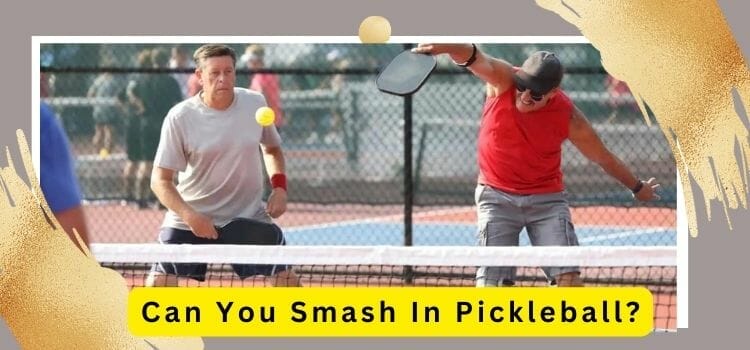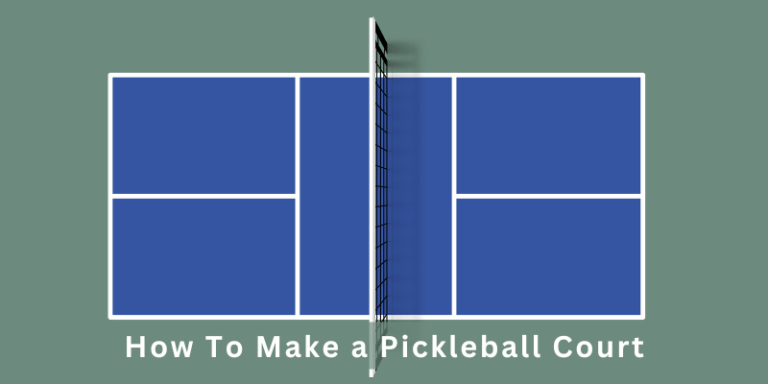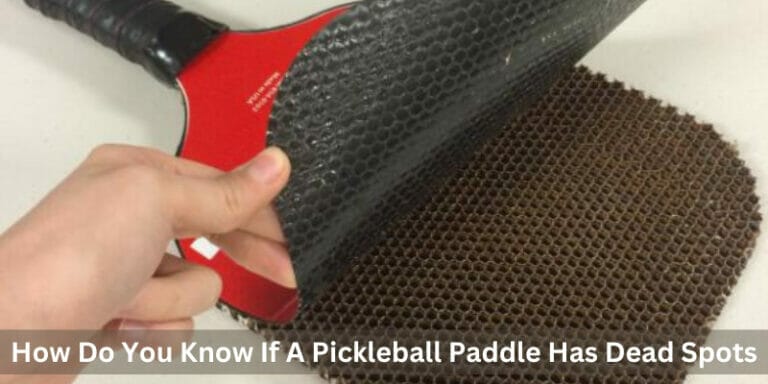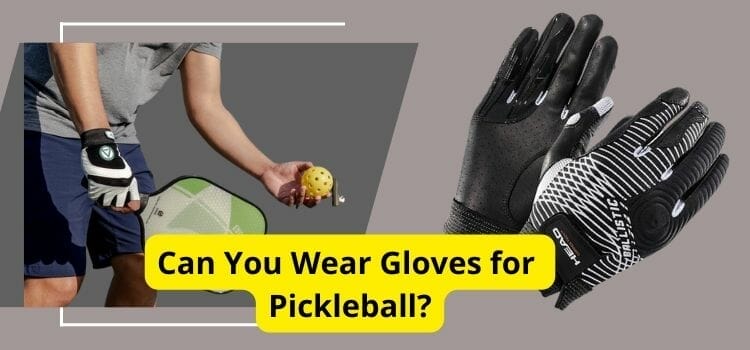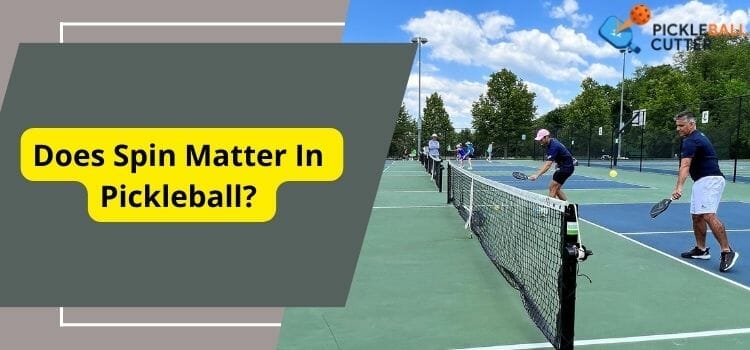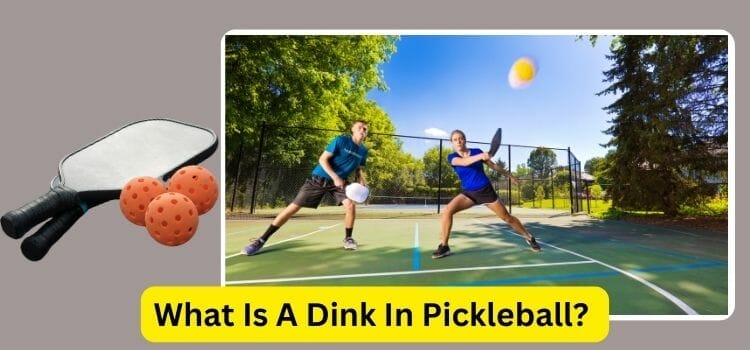What Are Pickleball Courts Made Of | Comprehensive Guide
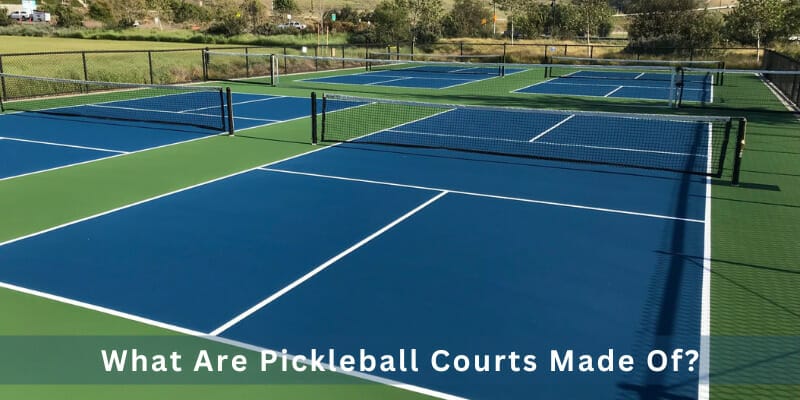
Don’t settle for a mediocre pickleball experience – educate yourself on the materials that make up the perfect court.
Pickleball courts can be made of different surfaces such as hard courts, grass courts, clay courts, and carpet courts. Indoor courts can be made of surface coatings like Pro-Cushion, Acrylate, or Plexiform. Pickleball can also be played on a tennis court.
When I first started playing pickleball, I had no idea what the court was made of. All I knew was that it was a fun and exciting game that I couldn’t get enough of.
It wasn’t until I started playing on different surfaces that I realized how important the court material was. Some surfaces were slick and slippery, while others were rough and gritty.
I quickly learned that I preferred playing on smoother surfaces, as it allowed for better movement and control of the ball.
Now, every time I step onto a pickleball court, I take note of the surface and adjust my game accordingly.
In this article, we provide a comprehensive guide on what pickleball courts are made of, and the benefits and drawbacks of each type of surface.
What are pickleball courts made of – Comprehensive Guide
A pickleball court surface is the playing area of a pickleball court, typically made of hard and smooth material with specific dimensions and markings for the game of pickleball.
A. What are Pickleball courts made of?
Pickleball courts can be made of a variety of materials, with each material providing different characteristics that affect the game play.
The most common materials used in the construction of Pickleball courts are concrete, asphalt, acrylic, grass, clay, and carpet.
Each of these materials has its own unique characteristics that can affect how the ball bounces, how players move on the court, and how the court is maintained.
B. Importance of the Pickleball Court Surface
The Pickleball court surface plays an important role in the game of Pickleball. The surface affects the gameplay by influencing the speed of the ball, the way the ball bounces, and the ability of players to move on the court.
The surface also affects the maintenance required to keep the court in good condition.
Choosing the right court surface is important to ensure that players have a good experience while playing.
C. Overview of Pickleball Court Surface Options
There are several options for Pickleball court surfaces, each with its own advantages and disadvantages.
Grass courts offer a unique playing experience but require significant maintenance.
Clay courts are common in tennis courts but are less popular in Pickleball due to their high maintenance requirements.
Carpet courts are a relatively new option and provide a softer surface that is easier on players’ joints.
Types of Pickleball Court Surfaces
There are different types of surfaces used for pickleball courts. The choice of surface can affect the speed of play, ball bounce, and player comfort, so it’s important to consider the advantages and disadvantages of each option before choosing one for your court.
1. Hard Courts
Hard courts are a common type of pickleball court surface and are made up of rigid materials that provide a solid and durable playing surface.
These courts are usually constructed using concrete or asphalt, and are generally considered to be the most affordable option for pickleball courts.
Hard courts provide a consistent surface that is ideal for beginners and intermediate players. The surface of these courts is relatively fast, which allows for quick and responsive play.
Hard courts are also relatively low-maintenance and can withstand heavy use over time. They have a flat and smooth surface with minimal cushioning, allowing for a fast-paced game.
Materials used in Hard Courts
Hard courts are typically made of a base layer of concrete or asphalt, which is covered with an acrylic surface layer.
Concrete and asphalt are the most commonly used materials in the construction of hard courts.
Concrete courts are typically more expensive than asphalt courts, but offer greater durability and require less maintenance over time.
The surface layer is painted with the lines and markings required for the game.
Advantages of Hard Courts
- Easy to maintain and clean
- Durable and long-lasting
- Provides a fast-paced game with consistent ball bounce
- Can be used in different weather conditions
Disadvantages of Hard Courts
- Hard surface can be tough on joints and lead to injuries
- Surface can become slippery when wet
- May require resurfacing over time, which can be expensive
- Lack of cushioning can lead to player fatigue and impact injuries.
2. Grass Courts
Grass courts are natural turf surfaces that are often used for sports such as soccer and cricket.
These types of courts are also suitable for Pickleball, although they are not as common as hard courts.
Grass courts provide a unique playing experience that is different from other types of surfaces, as the ball bounces differently on natural turf than on synthetic materials.
Materials used in Grass Courts
Grass courts are made from natural grass, typically a combination of different grass types such as Bermuda, Zoysia, and Bahia.
These grasses are chosen for their ability to withstand heavy traffic and recover quickly from damage.
Advantages of Grass Courts
- Provides a unique playing experience
- Soft surface reduces risk of injuries
- Cooler surface temperature compared to hard courts
- Environmentally friendly
Disadvantages of Grass Courts
- High maintenance requirements
- Grass can become slippery when wet
- Limited availability and high cost
- Requires regular mowing and watering
3. Clay Courts
Clay courts are a popular option in tennis and are occasionally used in Pickleball as well.
These courts are made up of natural clay or crushed brick and are often referred to as “red clay” or “clay” courts.
The surface is soft and slow, with the ball bouncing higher and slower than on other surfaces.
Materials used in Clay Courts
Clay courts are typically constructed using crushed brick or natural clay. The surface is then coated with a layer of Har-Tru or similar clay court material.
Advantages of Clay Courts
- Provides a unique playing experience with slower and higher bounces.
- Can be forgiving on players’ joints.
- Allows players to slide and make sharp turns more easily.
Disadvantages of Clay Courts
- High maintenance is required, including frequent watering and rolling to maintain the surface consistency.
- Can be easily damaged by rain and are often closed during wet weather.
- May require longer drying time after a rain or heavy watering, resulting in delays or cancellations of matches.
4. Carpet Courts
Carpet courts are a newer option for Pickleball court surfaces. They are made of synthetic materials that mimic the feel of a carpet.
Carpet courts are usually installed over a hard surface such as concrete or asphalt.
Materials used in Carpet Courts
Carpet courts are typically made of a synthetic carpet material with a foam backing for cushioning.
The carpet can be made from a variety of materials, including nylon and polypropylene.
The foam backing provides shock absorption and helps reduce strain on players’ joints.
Advantages of Carpet Courts
- Carpet courts provide a softer surface that is easier on players’ joints, reducing the risk of injury.
- They offer good traction and a consistent bounce.
- They are low-maintenance and require minimal upkeep compared to other surfaces like clay or grass.
Disadvantages of Carpet Courts
- Carpet courts can be expensive to install.
- They are not as durable as hard courts and may need to be replaced more frequently.
- The carpet surface can be prone to wear and tear, leading to possible tripping hazards.
Indoor Pickleball Courts
Indoor Pickleball courts are designed to be played in an enclosed, climate-controlled environment.
These courts are typically found in sports complexes, recreation centers, gyms, and other indoor facilities.
Indoor courts offer several advantages over outdoor courts, such as protection from inclement weather, controlled lighting conditions, and a consistent playing surface.
They are usually made of hard surfaces such as concrete or wood. The surface may be coated with materials such as acrylic or rubber to provide better traction and shock absorption.
Some indoor courts may also be made of carpet or turf to provide a softer surface and reduce the impact on players’ joints.
Indoor Pickleball courts are becoming increasingly popular due to their convenience and availability year-round.
However, playing indoors may require additional fees or memberships, and players may need to bring their own equipment or rent it from the facility.
Materials used in Indoor Pickleball Courts
Indoor Pickleball courts are typically made with a hard surface such as wood, synthetic materials, or poured rubber.
These surfaces are specifically designed to provide good ball bounce, comfortable player movement, and a high level of durability.
Wood and synthetic surfaces are the most commonly used materials in indoor Pickleball courts due to their excellent playing characteristics, ease of maintenance, and long-lasting durability.
Poured rubber surfaces are also becoming more popular due to their cushioned feel and resistance to wear and tear.
Additionally, indoor Pickleball courts often have added features such as line markings, lighting, and air conditioning to ensure the best possible playing experience for players.
Advantages and Disadvantages of Indoor Pickleball Courts
Here are some advantages and disadvantages of indoor Pickleball courts:
Advantages
- Weather-resistant: Indoor Pickleball courts are not affected by weather conditions, making them ideal for year-round play in areas with extreme weather.
- Controlled environment: The indoor environment allows for better control over lighting, temperature, and humidity, creating a consistent playing experience.
- Multi-purpose use: Indoor courts can be used for other activities such as basketball, volleyball, and badminton, making them a more versatile option for recreational facilities.
Disadvantages
- Higher cost: Indoor courts require construction and maintenance costs, making them more expensive than outdoor courts.
- Limited space: Indoor courts are often smaller in size than outdoor courts, which can limit the number of players who can participate in a game.
- Increased noise levels: Indoor courts can produce more noise due to the sound reflecting off walls and floors, creating a potential distraction for players.
Pickleball Court Surface Coatings
Pickleball Court Surface Coatings are specialized coatings that are applied to the court surface to provide additional cushioning, traction, and durability.
These coatings are designed to enhance the playing experience for Pickleball players and extend the life of the court surface.
1. Pro-Cushion Surface
Pro-Cushion surface is a specialized coating that is applied on top of a hard court surface.
This coating is designed to provide players with a softer and more forgiving playing surface, reducing the impact on joints and allowing for longer play sessions.
The surface is made up of multiple layers of acrylic material, including a cushion layer that provides the softness.
Materials used in Pro-Cushion Surface
The materials used in the Pro-Cushion surface include acrylic resins, sand, rubber particles, and a cushion layer made of foam.
The mixture is applied to the hard-court surface and is then finished with a textured top layer that provides grip and durability.
Advantages of Pro-Cushion Surface
- Provides a softer playing surface that is easier on joints and allows for longer play sessions.
- Reduces the risk of injuries from falls.
- Enhances the performance of the ball by providing consistent bounce and speed.
- Improves the durability of the court surface by protecting it from damage caused by weather and use.
Disadvantages of Pro-Cushion Surface
- Can be more expensive to install compared to other court surfaces.
- Requires regular maintenance to keep the surface in good condition.
- May require additional time for the surface to dry after rain.
- Not suitable for outdoor use in extreme weather conditions.
2. Acrylotex
Acrylotex is a type of coating used on Pickleball courts that is made up of a mixture of acrylic resins, sand, and rubber particles.
This coating is designed to provide a durable and textured playing surface that offers good grip and consistent ball bounce.
Materials used in Acrylotex
The materials used in Acrylotex include acrylic resins, sand, and rubber particles. These materials are mixed together and applied to the Pickleball court surface, creating a textured surface that provides good grip and consistent ball bounce.
Advantages of Acrylotex
- Provides a durable and textured playing surface that offers good grip and consistent ball bounce.
- Resistant to damage caused by weather and use, making it a good choice for outdoor Pickleball courts.
- Requires less maintenance compared to other coatings, reducing long-term costs.
- Available in a range of colors to create unique and custom court designs.
Disadvantages of Acrylotex
- Can be more expensive than other court surfaces, such as concrete or asphalt.
- May require additional time for the surface to dry after rain.
- The texture of the surface may cause more wear and tear on shoes compared to smoother surfaces.
- Requires professional installation, which may add to the overall cost.
3. Plexiflor
Plexiflor is a specialized coating used on top of concrete or asphalt surfaces to create a durable, non-slip playing surface for pickleball.
It is a multi-layered system that includes a cushion layer to reduce joint impact and increase player comfort.
Materials used in Plexiflor
Plexiflor is made up of multiple layers of polyurethane and acrylic resins, as well as rubber particles and sand. The cushion layer is made of a shock-absorbing foam material.
Advantages of Plexiflor
- Provides a durable, non-slip playing surface that is suitable for outdoor use.
- The cushion layer helps to reduce joint impact and increase player comfort.
- Resistant to damage from weather and heavy use.
- Easy to clean and maintain.
Disadvantages of Plexiflor
- Can be more expensive to install compared to other court surfaces.
- May require regular re-coating to maintain the surface’s non-slip properties.
- Can become slippery when wet, so caution is required during rainy weather.
Playing Pickleball on A Tennis Court
Pickleball can be played on a tennis court by using temporary pickleball lines and modifying the rules to fit the smaller court size.
The standard tennis court size is 78 feet long and 36 feet wide, while the standard pickleball court size is 44 feet long and 20 feet wide.
To play pickleball on a tennis court, temporary pickleball lines can be taped or painted onto the surface to mark the smaller court size.
The net height can also be adjusted to the standard pickleball height of 36 inches.
Modifications to the rules include playing with a softer ball and allowing for one bounce before returning the ball.
Playing on a tennis court can provide a unique challenge as the larger court size can require players to cover more ground and adjust their strategy accordingly.
It also allows for more players to participate in the game, as four players can play doubles on a single tennis court.
However, it is important to ensure that the tennis court surface is suitable for playing pickleball to prevent injuries and ensure fair play.
Advantages of Playing Pickleball on a Tennis Court
- Cost-effective as it utilizes an existing tennis court.
- Availability, as tennis courts are more widely available than dedicated Pickleball courts.
- Provides a different playing experience with a larger court size.
Disadvantages of Playing Pickleball on a Tennis Court
- The size of the tennis court is larger than a standard Pickleball court, making it harder to cover the distance.
- The surface of a tennis court may not be ideal for Pickleball, as it can be too fast and cause the ball to bounce higher than usual.
- The temporary Pickleball court lines may not always be available, leading to inconsistencies in court setup.
Factors to Consider in Choosing Pickleball Court Surface
When selecting a pickleball court surface, there are several factors to consider that can affect the playing experience, maintenance requirements, and overall cost.
1. Climate and Weather Conditions
The climate and weather conditions of the location where the court will be installed must be considered when choosing a surface. Some surfaces may not be suitable for extreme weather conditions such as high heat, heavy rain, or snow.
2. Budget and Cost
The budget and cost of installing and maintaining the court surface must be taken into account. Some surfaces may be more expensive to install and require more maintenance than others.
3. Maintenance and Durability
The maintenance and durability of the court surface are important factors to consider. Some surfaces may require more maintenance and repair than others, and some may have a shorter lifespan.
4. Level of Play
The level of play of the players who will be using the court must also be considered. Some surfaces may be better suited for advanced or professional players, while others may be more suitable for recreational players.
Conclusion
In conclusion, there are four main types of court surfaces including hard courts, grass courts, clay courts, and carpet courts, each one have its own advantages and disadvantages.
And factors such as climate, budget, maintenance, and level of play should be considered when choosing the right one.
It is important to understand the impact of the court surface on the game and to make an informed decision to ensure a satisfying and safe pickleball experience.
Ultimately, the right court surface can greatly enhance the overall game experience, allowing players to play longer, safer, and with greater consistency.
FAQs
What Is The Best Material For A Pickleball Court?
The best material for a pickleball court depends on various factors such as climate, budget, and level of play. No single material is considered the best for all situations.
What Material Is A Pickleball Court?
A pickleball court can be made of various materials such as concrete, asphalt, wood, or synthetic materials like acrylic or rubber.
Is Pickleball Ever Played On Clay Courts?
Yes, pickleball can be played on clay courts, but it requires specific equipment and maintenance to ensure the surface is suitable for the game.
What Is The Difference Between Tennis Court And Pickleball Court?
The main differences between tennis and pickleball courts are their size, layout, and surface. Pickleball courts are smaller, have different dimensions, and have a different surface texture than tennis courts.

